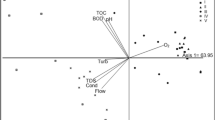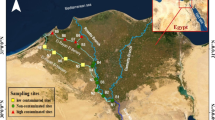Abstract
Benthic invertebrates were collected from a subarctic lake during 1976 to assess the effectiveness of diversity indices and indicator species as measures of heavy metal pollution. Collections were made near an operating metal mine, where sediments were contaminated with high levels of arsenic (up to 2,500 mg/kg dry weight), mercury (500 µg/kg), lead (850 mg/kg), copper (750 mg/kg) and zinc (950 mg/kg). A total of 25 species and a diversity index of 2.4—2.9 were recorded in this heavily impacted area. Chironomids (Procladius denticulatus, Heterotrissocladius changi, Chironomus decorus) were most common in the sediments, followed in importance by molluscs (Pisidium casertanum) and oligochaetes (Lumbriculus variegatus). There were 23 and 25 species in the areas of moderate and negligible contamination, respectively. The diversity indices ranged from 2.4–2.6 and 2.4–2.8 and the main species were generally similar to those found in the heavily impacted area. While diversity indices and indicator species were therefore ineffective in monitoring metal contamination, the strong negative correlation between the concentration of metals and the abundance of benthic organisms provided a much more realistic assessment of the level of contamination.
Similar content being viewed by others
References
Bousfield, E. L. 1958. Fresh-water amphipod crustaceans of glaciated North America. Can. Field-Nat. 72: 55–113.
Brinkhurst, R. O. 1976. Aquatic Oligochaeta recorded from Canada and the St. Lawrence Great Lakes. Inst. Ocean Sci., Pacific Mar. Sci. Rep. 76–4: 1–49.
Brinkhurst, R. O. & Cook, D. G. 1974. Aquatic earthworms (Annelda: Oligochaeta). In: Pollution ecology of freshwater invertebrates. C. W. Hart and S. L. H. Fuller, eds, Academic Press, New York. pp. 143–156.
Brundin, L. 1949. Chironomiden und andere Bodentiere der südschwedischen Urgebirgseen. Rep. Inst. Freshwat. Res. Drottningholm 37: 1–185
Cairns, J. C., Lanza, G. R. & Parker, B. C. 1972. Pollution related structural and functional changes in aquatic communities with emphasis on freshwater algae and protozoa. Proc. Acad. Nat. Sci. Philadelphia 124: 79–127.
Clarke, A. H. 1973. The freshwater molluscs of the Canadian interior basin. Malacologia 13: 1–509.
Devaux, J. 1975. Succession écologique, diversité spécifique et production primaire dans un lac oligotrophe d'Auvergne (France). Verh. Internat. Verein. Limnol. 19: 1165–1171.
Driver, E. A. 1977. Chironomid communities in small prairie ponds: some characteristics and controls. Freshwat. Biol. 7: 121–133.
Eberhardt, L. L. 1969. Some aspects of species diversity models. Ecology 50: 503–505.
Godfrey, P. J. 1978. Diversity as a measure of benthic macroinvertebrate community response to water pollution. Hydrobiologia 57: 111–122.
Hurlbert, S. H. 1971. The concept of species diversity: A critique and alternate parameters. Ecology 52: 577–586.
Johnson, M. G. & Brinkhurst, R. O. 1971. Associations and species diversity in benthic macroinvertebrates of Bay of Quinte and Lake Ontario. J. Fish. Res. Bd Can. 28: 1683–1697.
Jones, J. R. E. 1938. The relative sensitivity of aquatic species to lead in solution. J. Anim. EcOl. 7: 287–289.
Jones, J. R. E. 1940. The fauna of the river Melindwr, a lead-polluted tributary of the river Rheidol in North Cardiganshire, Wales. J. Anim. Ecol. 9: 188–201.
Laurie, R. D. & Jones, J. R. E. 1938. The faunistic recovery of a lead polluted river in north Cardiganshire, Wales. J. Anim. Ecol. 7: 272–286.
Lively, J. P. 1974. Analytical methods manual. Inland Waters Directorate, Water Quality Branch, Environment Canada, Ottawa.
Mathis, B. J. & Dorris, T. C. 1968. Community structure of benthic macroinvertebrates in an intermittent stream receiving oil field brines. Amer. Midi. Nat. 8o: 428–439.
Oliver, D. R. 1963. Entomological studies in the Lake Hazen area, Ellesmere Island, including lists of Arachnida, Collembola, and Insecta. Arctic 16: 175–180.
Oliver, D. R. 1964. A limnological investigation of a large arctic lake, Nettilling Lake, Baffin Island. Arctic 17: 69–83.
Oliver, D. R. 1976. Chironomidae (Diptera) of Char Lake Cornwallis Island, N.W.T., with descriptions of two new species. Can. Ent. 108: 1053–1064.
Roback, S. S. 1970. The adults of the subfamily Tanypodinae (= Pelopiinae) in North America (Diptera: Chironomidae). Monogr. Acad. Nat. Sci. Philadelphia.
Roback, S. S. 1974. Insects (Arthropoda: Insecta). In: Pollution ecology of freshwater invertebrates. C. W. Hart and S. L. H. Fuller, eds, Academic Press, New York, pp. 313–376.
Saether, O. A. 1975a. Two new species of Heterotanytarsus Spärk, with keys to Nearctic and Palaearctic males and pupae of the genus (Diptera: Chironomidae). J. Fish. Res. Bd Can. 32: 259–270.
Saether, O. A. 1975b. Two new Nearctic species of Protanypus Kieffer with keys to Nearctic and Palearctic species of the genus (Diptera: Chironomidae). J. Fish. Res. Bd Can. 32: 367–388.
Saether, O. A. 1975c. Nearctic and Palearctic Heterotrissocladius Spärk (Diptera: Chironomidae). Bull. Fish. Res. Bd Can. 193: 1–67.
Saether, O. A. 1976. Revision of Hydrobaenus, Trissocladius, Zalutschia, Paratrissocladius, and some related genera (Diptera: Chironomidae). Bull. Fish. Res. Bd Can. 195: 1–287.
Sawyer, R. T. 1973. Bloodsucking freshwater leeches: observations on control. J. Econ. Entomol. 66: 537.
Slobodchikoff, C. N. & Parrott, J. E. 1977. Seasonal diversity in aquatic insect communities in an all-year stream system. Hydrobiologia 52: 143–151.
Shannon, C. D. & Weaver, W. 1949. The mathematical theory of communication. Univ. Illinois Press, Urbana.
Townes, H. K. 1945. The Nearctic species of Tendipidini. Amer. Midi. Nat. 34: 1–206.
Warren, C. E. 1971. Biology and water pollution control. W. B. Saunders, Toronto.
Wilhm, J. 1967. Composition of some diversity indices applied to populations of benthic macroinvertebrates in a stream receiving organic wastes. J. Wat. Poll. Cont. Fed. 39: 1674–1683.
Wilhm, J. 1968. Biomass units versus numbers of individuals in species diversity indices. Ecology 49: 153–156.
Wilhm, J. 1970. Range of diversity index in benthic macroinvertebrate populations. J. Wat. Poll. Cont. Fed. 42: 221–224.
Wilhm, J. & Dorris, T. C. 1966. Species diversity of benthic macroinvertebrates in a stream receiving domestic and oil refinery effluents. Amer. Midi. Nat. 76: 427–449.
Winner, R. W., Van Dyke, J. S., Caris, N. & Farrel, M. P. 1975. Response of the macroinvertebrate fauna to a copper gradient in an experimentally-polluted stream. Verh. Internat. Verein. Limnol. 19: 2121–2127.
Author information
Authors and Affiliations
Rights and permissions
About this article
Cite this article
Moore, J.W. Diversity and indicator species as measures of water pollution in a subarctic lake. Hydrobiologia 66, 73–80 (1979). https://doi.org/10.1007/BF00019142
Received:
Issue Date:
DOI: https://doi.org/10.1007/BF00019142




